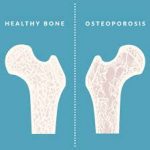Table of Contents
What is osteoporosis?

Osteoporosis is characterized by reduced bone mass. The body breaks down more bone tissue than it can replace. Hence, bones become weak and fragile resulting in increased fracture incidence. The inside of a healthy bone has small spaces. Osteoporosis increases the size of these spaces, causing the bone to lose strength and density.
How bad is my osteoporosis?
A BMD test measures bone mineral density and compares it to that of an established standard to give you a T score. A T score of above -1.0 is normal bone density.
Mild: It indicates T score of -1. Usually it is asymptomatic but sometimes you may have weak grip strength, and brittle nails.
Moderate: T score is between -1 and -2.5; The other symptoms are receding gums, back pain, neck pain, joint pain and muscle pain. It may limit instrumental activities of daily life (preparing meals, managing money, shopping, doing housework, and using a telephone).
Severe: A T-score of below -2.5 is a diagnosis of osteoporosis. Other symptoms are gradual height loss (more than or equal to 2 cm), stooped posture and tiny cracks in your bones. It may limit self-care activities of daily life (eating, dressing, getting into or out of a bed or chair, taking a bath or shower, and using the toilet). See your doctor immediately if you are experiencing severe pain in your back, neck, hip, or wrist.
How to manage mild osteoporosis?
Keep track of your symptoms using Ankr (myAnkr web portal or the Ankr app). It will help you describe the discomfort to your doctor or nurse.
- The current recommendations for taking calcium and vitamin D supplements are listed below.
- Vitamin D: 800 to 1,000 international units (IU) per day
- Calcium supplements: 1,000 to 1,200 milligrams (mg) per day
- For women before menopause: 1,000 mg per day
- For women after menopause: 1,200 mg per day
2. Weight-bearing physical activity (walking, dancing, stair climbing) puts stress on your bones. This triggers the body to make cells that form bone. Regular weight-bearing exercise builds strong muscles.
3. Eat a well-balanced diet. Being underweight can contribute to bone loss and fractures.
4. Falling is the main cause of fractures for people with osteoporosis.
- Poor vision
- Shoes that do not fit well
- A cluttered living space
- Mental impairment
- Drowsiness
- Poor concentration
How to manage moderate and severe osteoporosis?
The symptoms can cause pain and discomfort. See a doctor immediately if you are experiencing severe pain in the back, neck, hip, or wrist. You may have a fractured bone that requires evaluation and treatment
What causes osteoporosis?
- Bone cancer
- Cancer that has spread to the bone:
- Breast cancer
- Prostate Cancer
- Multiple myeloma
- Lung cancer
- Chemotherapy
- Menopausal women have high risk of osteoporosis because of lower levels of estrogen. Estrogen is a hormone that helps maintain bone density.
- Hormone therapy
- Heavy smoking and drinking alcohol.
- A family history
- Other medicines:
- Steroid therapy ( prednisone)
- Synthetic thyroid hormone therapy
- Drugs for heartburn
- Long-term bed rest and inactivity.
- Poor nutrition
- Low levels of calcium and vitamin D.
- Race and ethnic background: White or Asians are at increased risk
